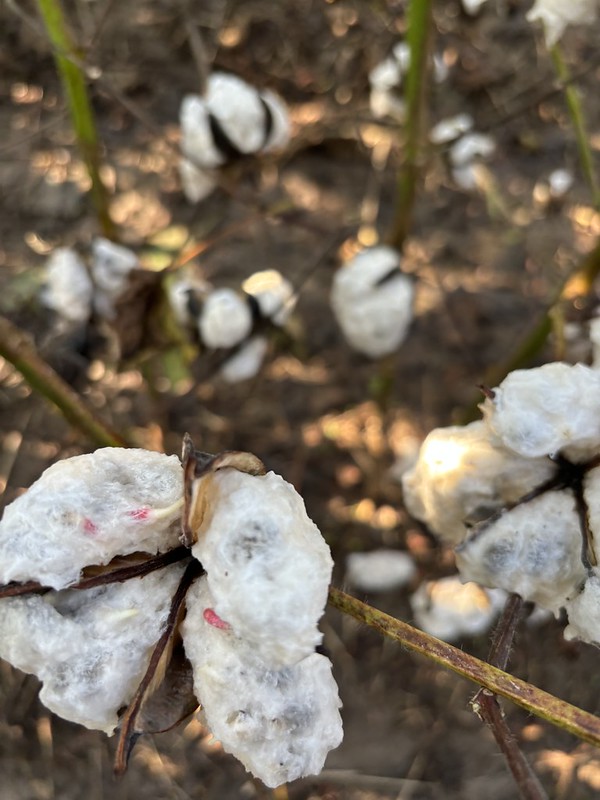YEAREND: Arkansas cotton, peanut production both suffer from wet spring, fall
Dec. 16, 2024
By Ryan McGeeney
U of A System Division of Agriculture
Fast Facts:
- Arkansas peanut acres jump by 33 percent over 2023
- Harvested cotton acreage falls from earlier prediction; still higher than ‘23
(465 words)
(Newsrooms: With file art of damaged cotton)
LITTLE ROCK — A wet May sharply curtailed expectations for Arkansas cotton growers in 2024, an experience similar to that of growers in many crops across the state.
Zachary Treadway, extension cotton and peanut agronomist for the University of Arkansas System Division of Agriculture, said conditions during planting were largely to blame.
“I got here in May, when the weather was very wet, as it should be — but there’s a limit,” Treadway said. “There was planting being abandoned, re-plants going in. Come June, July, it got hot and dry — that’s not really good for any crop.”
The state’s cotton growers rode the same weather rollercoaster everyone else did — too wet, too dry, too hot, suddenly cool.
“We suffered through those dog days of June and July,” Treadway said. “It really wasn’t ideal. At the end of July, it stayed hot, but we got some timely rain before it dried up again in August. Then we had rains in September with those two back-to-back hurricanes.”
Arkansas growers ultimately harvested 640,000 acres of cotton. Although this was a 30,000-acre decrease from spring projections, it was still a substantial increase of 135,000 acres over 2023 harvest numbers.
Treadway said that periodic rains near harvest likely impacted the quality of the crop, however.
“When those rains came in September, about half the state’s cotton crop had been defoliated,” he said. “So we had bolls that were open, and a lot of that fiber got rained on. It didn’t kill us — it’s not the worst thing in the world — but it’s not ideal. As long as that fiber didn’t get washed out of that boll, we’re still able to pick that cotton.
While 2024 Arkansas cotton yield numbers haven’t been finalized, Treadway estimated totals would be about 1,200 pounds per acre on average, or about 95 pounds per acre less than 2023.
Peanuts
Arkansas peanuts experienced an explosion in acreage this year, rising by 10,000 acres over 2023’s reported acreage to 44,000 acres. Given the highly specialized nature of peanut harvesting equipment, Treadway said, it’s likely that the expansion in acreage does not represent new growers moving into the crop, but rather the same growers expanding their peanut efforts.
Because the peanut and cotton growing seasons are similar, Treadway said, the same forces that robbed the state’s cotton growers of some of their yield likely impacted Arkansas peanuts as well.
“USDA has us averaging about 5,300 pounds per acre,” he said. “Talking to growers, I think we’ll land around 5,200 pounds, which is about a 500-pound-per-acre decrease from ’23.
“I think the decrease in both cotton and peanut yield per acre tie into the strange weather patterns we had this year,” Treadway said. “But with the increase in acres, we’re up 18 percent in terms of peanuts produced in the state.”
To learn about extension programs in Arkansas, contact your local Cooperative Extension Service agent or visit www.uaex.uada.edu. Follow us on X and Instagram at @AR_Extension. To learn more about Division of Agriculture research, visit the Arkansas Agricultural Experiment Station website: https://aaes.uada.edu/. Follow on X at @ArkAgResearch. To learn more about the Division of Agriculture, visit https://uada.edu/. Follow us on X at @AgInArk.
About the Division of Agriculture
The University of Arkansas System Division of Agriculture’s mission is to strengthen agriculture, communities, and families by connecting trusted research to the adoption of best practices. Through the Agricultural Experiment Station and the Cooperative Extension Service, the Division of Agriculture conducts research and extension work within the nation’s historic land grant education system.
The Division of Agriculture is one of 20 entities within the University of Arkansas System. It has offices in all 75 counties in Arkansas and faculty on five system campuses.
The University of Arkansas System Division of Agriculture offers all its Extension and Research programs to all eligible persons without regard to race, color, sex, gender identity, sexual orientation, national origin, religion, age, disability, marital or veteran status, genetic information, or any other legally protected status, and is an Affirmative Action/Equal Opportunity Employer.
# # #
Media Contact:
Ryan McGeeney
rmcgeeney@uada.edu
@Ryan_McG44
501-671-2120
